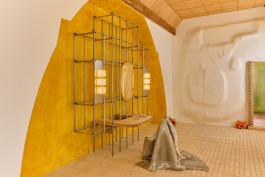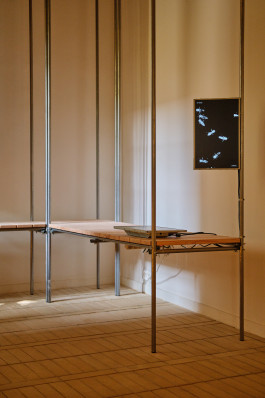
VOTO XO

Melitosfex, 2023
Melitosfex comes from mellitosphex burmensis, the name given to the oldest known bee to date, a queen fossilized in a piece of amber dating from the Cretaceous period, a hundred million years ago.
We imagined the environment of this half-bee, half-wasp character, like an archaic queen, whose attributes of civilization would appear to us today. We added our free interpretation to our research in the form of a space evoking the secret chamber of this queen bee, Melitosfex.
Our investigation began when we tried to welcome a swarm of black bees three years ago in the Var. We tried to understand how they work with each other and with their environment, how they communicate, choose their queen, reproduce, read flowers or paint pollen. The study of their behavior evoked the imagination of a people who were both ancient and very complex.
Images © Luc Bertrand




We created an interior that uses the formal codes of the hive. On the one hand, the rigorous architecture of the wooden panels, the repetition of quadrilateral units, the steel tube frames ready to be dismantled for departure and the sobriety of materials such as wood, earth and paper. These elements invoke the geometric succession of cells and the precise organization of the hive in a wild, sometimes hostile context.
On the other hand, we have the softness of bronze which seems to melt, the transparency of glass, the smell of wax. These illustrate the organic character of the hive and the liquid materials worked by the bees: wax, honey, royal jelly.



The queen bee has a royal dressing table to get ready, stingers to defend herself, and loot that she jealously hides in her safe. She keeps an eye on her hive from her tracking station. It remains cool, behind a wall of waxed paper and under a ventilated wooden roof. Two twisted columns mark the threshold of this door which she crosses day and night.
We like to undertake research, here around the behaviors of the bee, extract constructive and decorative principles, to propose an interior one can dive into. This exhibition offered us the opportunity to collaborate with many art professionals, artisans, designers and maison d’art with exceptional know-how.



Melitosfex, 2023
Melitosfex comes from mellitosphex burmensis, the name given to the oldest known bee to date, a queen fossilized in a piece of amber dating from the Cretaceous period, a hundred million years ago.
We imagined the environment of this half- bee, half-wasp character, like an archaic queen, whose attributes of civilization would appear to us today. We added our free interpretation to our research in the form of a space evoking the secret chamber of this queen bee, Melitosfex.
Our investigation began when we tried to welcome a swarm of black bees three years ago in the Var. We tried to understand how they work with each other and with their environment, how they communicate, choose their queen, reproduce, read flowers or paint pollen. The study of their behavior evoked the imagination of a people who were both ancient and very complex.
Images © Luc Bertrand




We created an interior that uses the formal codes of the hive. On the one hand, the rigorous architecture of the wooden panels, the repetition of quadrilateral units, the steel tube frames ready to be dismantled for departure and the sobriety of materials such as wood, earth and paper. These elements invoke the geometric succession of cells and the precise organization of the hive in a wild, sometimes hostile context.
On the other hand, we have the softness of bronze which seems to melt, the transparency of glass, the smell of wax. These illustrate the organic character of the hive and the liquid materials worked by the bees: wax, honey, royal jelly.



The queen bee has a royal dressing table to get ready, stingers to defend herself, and loot that she jealously hides in her safe. She keeps an eye on her hive from her tracking station. It remains cool, behind a wall of waxed paper and under a ventilated wooden roof. Two twisted columns mark the threshold of this door which she crosses day and night.
We like to undertake research, here around the behaviors of the bee, extract constructive and decorative principles, to propose an interior one can dive into. This exhibition offered us the opportunity to collaborate with many art professionals, artisans, designers and maison d’art with exceptional know-how.


